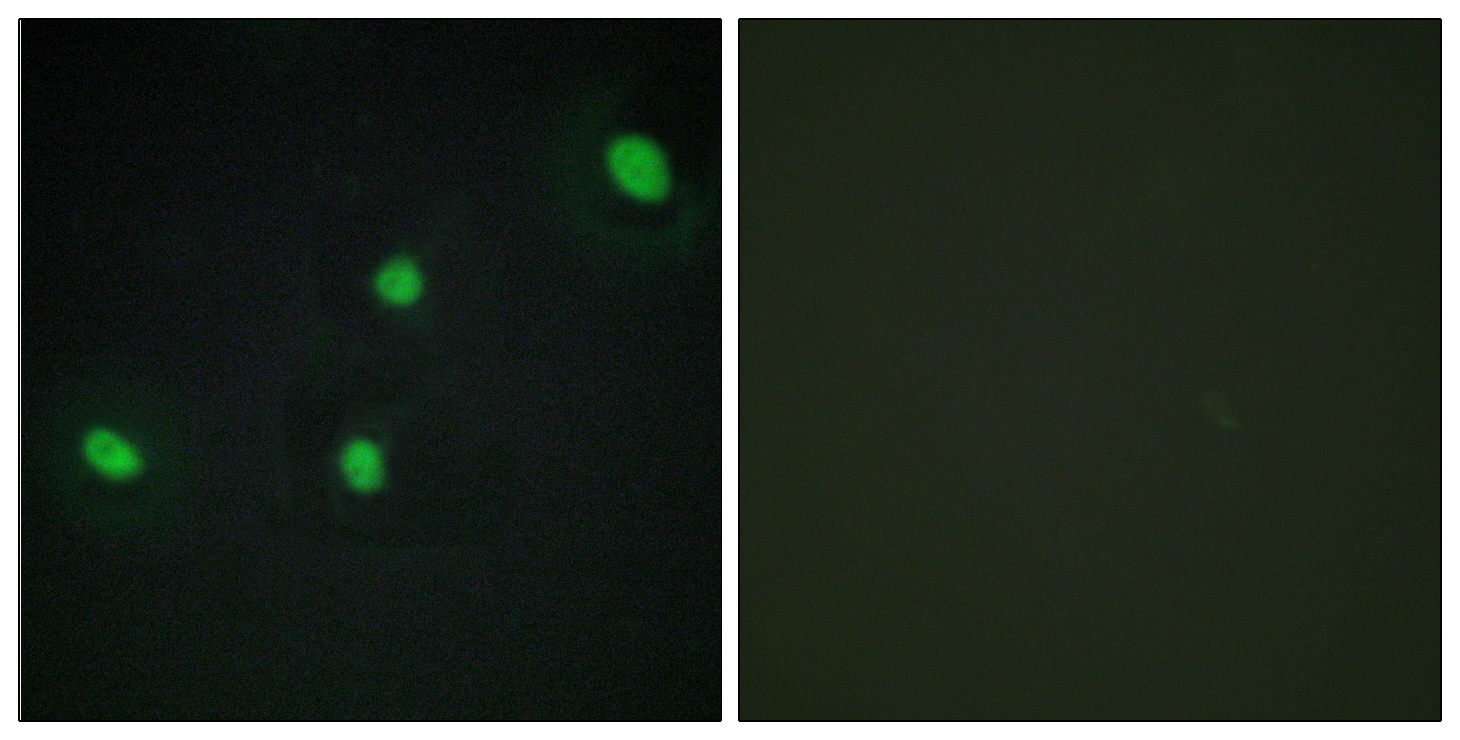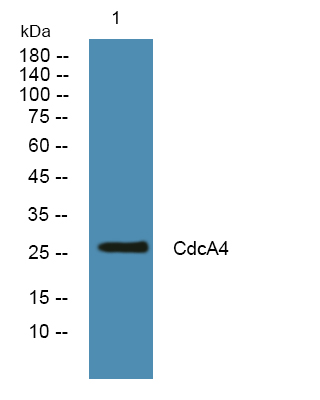CdcA4 Polyclonal Antibody
- Catalog No.:YT0820
- Applications:IHC;IF;WB;ELISA
- Reactivity:Human;Mouse
- Target:
- CdcA4
- Gene Name:
- CDCA4
- Protein Name:
- Cell division cycle-associated protein 4
- Human Gene Id:
- 55038
- Human Swiss Prot No:
- Q9BXL8
- Mouse Gene Id:
- 71963
- Mouse Swiss Prot No:
- Q9CWM2
- Immunogen:
- The antiserum was produced against synthesized peptide derived from human CDCA4. AA range:121-170
- Specificity:
- CdcA4 Polyclonal Antibody detects endogenous levels of CdcA4 protein.
- Formulation:
- Liquid in PBS containing 50% glycerol, 0.5% BSA and 0.02% sodium azide.
- Source:
- Polyclonal, Rabbit,IgG
- Dilution:
- WB 1:500-2000 IHC 1:100 - 1:300. IF 1:200 - 1:1000. ELISA: 1:5000. Not yet tested in other applications.
- Purification:
- The antibody was affinity-purified from rabbit antiserum by affinity-chromatography using epitope-specific immunogen.
- Concentration:
- 1 mg/ml
- Storage Stability:
- -15°C to -25°C/1 year(Do not lower than -25°C)
- Other Name:
- CDCA4;HEPP;Cell division cycle-associated protein 4;Hematopoietic progenitor protein
- Observed Band(KD):
- 26kD
- Background:
- cell division cycle associated 4(CDCA4) Homo sapiens This gene encodes a protein that belongs to the E2F family of transcription factors. This protein regulates E2F-dependent transcriptional activation and cell proliferation, mainly through the E2F/retinoblastoma protein pathway. It also functions in the regulation of JUN oncogene expression. This protein shows distinctive nuclear-mitotic apparatus distribution, it is involved in spindle organization from prometaphase, and may also play a role as a midzone factor involved in chromosome segregation or cytokinesis. Two alternatively spliced transcript variants encoding the same protein have been noted for this gene. Two pseudogenes have also been identified on chromosome 1. [provided by RefSeq, May 2014],
- Function:
- function:May participate in the regulation of cell proliferation through the E2F/RB pathway. May be involved in molecular regulation of hematopoietic stem cells and progenitor cell lineage commitment and differentiation.,induction:By E2F1.,similarity:Contains 1 SERTA domain.,tissue specificity:Highest levels of expression in the pancreas, thymus, testis, spleen, liver, placenta and leukocytes. Relatively low levels in the lung, kidney, prostate, ovary, small intestine and colon. Hardly detectable, if at all, in the brain, skeletal muscle and heart.,
- Subcellular Location:
- Nucleus .
- Expression:
- Highest levels of expression in the pancreas, thymus, testis, spleen, liver, placenta and leukocytes. Relatively low levels in the lung, kidney, prostate, ovary, small intestine and colon. Hardly detectable, if at all, in the brain, skeletal muscle and heart.
CDCA4 as a novel molecular biomarker of poor prognosis in patients with lung adenocarcinoma. Frontiers in Oncology Xinglin Gao IHC Human
- June 19-2018
- WESTERN IMMUNOBLOTTING PROTOCOL
- June 19-2018
- IMMUNOHISTOCHEMISTRY-PARAFFIN PROTOCOL
- June 19-2018
- IMMUNOFLUORESCENCE PROTOCOL
- September 08-2020
- FLOW-CYTOMEYRT-PROTOCOL
- May 20-2022
- Cell-Based ELISA│解您多样本WB检测之困扰
- July 13-2018
- CELL-BASED-ELISA-PROTOCOL-FOR-ACETYL-PROTEIN
- July 13-2018
- CELL-BASED-ELISA-PROTOCOL-FOR-PHOSPHO-PROTEIN
- July 13-2018
- Antibody-FAQs
- Products Images

- Immunofluorescence analysis of HepG2 cells, using CDCA4 Antibody. The picture on the right is blocked with the synthesized peptide.

- Immunohistochemistry analysis of paraffin-embedded human brain tissue, using CDCA4 Antibody. The picture on the right is blocked with the synthesized peptide.

- Western blot analysis of lysates from A431 cells, primary antibody was diluted at 1:1000, 4°over night



